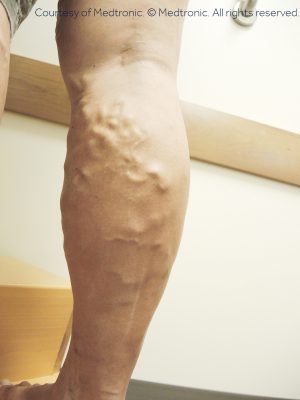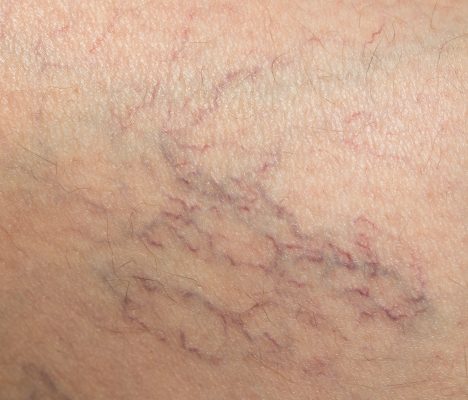Varicose Veins and Spider Veins
It’s a myth that varicose veins and spider veins are an inevitable part of the aging process. While they are more common in people over the age of 50, they are not in the same category as crows’ feet and laugh lines. Don’t assume you must simply accept and learn to live with abnormal veins. In fact, for the sake of your health, they shouldn’t be ignored. Varicose and spider veins may be a symptom of serious vein disease.

Fortunately, today’s treatments are fast, effective, and virtually painless. A specialized vein doctor in New York or vein doctor in New Jersey can offer you an accurate diagnosis and state-of-the-art treatments on-site.

Varicose Veins

Spider Veins
What Causes Varicose Veins and Spider Veins?
Your circulatory system is always at work, transporting blood throughout your body. Your heart pumps blood to the lungs, where it picks up oxygen. Then, arteries carry the oxygenated blood to your cells. Finally, veins move the deoxygenated blood back to your heart, where the cycle begins again.
The most difficult part of this process is moving blood from the lower half of your body to the heart, because your veins are fighting the forces of gravity. The vessels rely on a series of one-way valves that open to let blood through as it travels to the heart, then close to prevent backflow. When these valves are diseased or damaged, a number of issues occur.
Ineffective valves permit blood to leak backward, and it starts to pool in your lower half. Pressure builds in your veins, damaging other valves and the vein walls. This condition is called Chronic Venous Insufficiency or CVI.
Varicose veins and spider veins develop as the diseased blood vessels become thick, swollen, and twisted. Varicose veins eventually bulge against the skin, while spider veins appear just beneath the surface. You will notice small red, blue, or purple lines that resemble a spider’s web or a net. While varicose and spider veins are often completely painless at first, other symptoms may develop over time.
What are the Symptoms of Chronic Venous Insufficiency?
Varicose veins and spider veins may be among the earliest CVI symptoms, but unfortunately, more issues usually follow. Many patients report swelling in their legs and ankles and a feeling of tightness in their calves. Legs may feel heavy or weak, and it is common to feel achiness or throbbing pain. Typically, the pain is worse when you stand, and you might notice that it gets a bit better when you sit down with your feet up. Some individuals develop restless leg syndrome, which is marked by feeling a constant need to move or stretch your legs.
One of the most challenging symptoms of CVI is sudden, severe leg cramps. They can be extremely painful, and even though the pain recedes in a few seconds, many people have increased sensitivity in the area for another day or so. These cramps often occur at night, interrupting sleep, which adds to the overall impact on your daily activities.
As veins swell and put pressure on the skin, many patients notice itchiness and flaking. When the disease goes unaddressed, skin starts to thicken and take on a reddish-brown tone. This discoloration is most common in the area around your ankles. The condition is called Venous Stasis Dermatitis, and it can be dangerous if left untreated.
Skin affected by Venous Stasis Dermatitis is extremely fragile. When cuts and tears occur, they are slow to heal. Infection is a significant concern because minor cuts and abrasions can rapidly turn into major sores that are difficult to treat. Also known as Venous Stasis Ulcers, these sores dramatically affect your ability to enjoy normal everyday activities.
What are the Risk Factors for Varicose Veins and Spider Veins?
Conditions affecting the veins, including varicose and spider veins, are more common as you get older. However, it is possible to develop spider veins and varicose veins at any age. Women are at higher risk during pregnancy and menopause, and anyone with a family history of vein disease has a greater chance of being impacted.
Other health problems can contribute to issues with your veins, including cancer, blood clots, and injury or trauma to the leg. Lifestyle factors that increase your risk of vein disease include smoking, long periods of sitting or standing without a break, and being overweight. It is important to let your vein doctor know if any of these apply to you, as this information is helpful in accurately diagnosing CVI and choosing the most appropriate treatment.
How Are Varicose Veins and Spider Veins Treated?
For many years, the only treatment option for large varicose veins was an invasive surgery known as “vein stripping”. Fortunately, there have been significant advances in this area of medicine, and today’s treatment methods are simpler and more effective. Using a variety of minimally invasive techniques, vein specialists are able to close diseased veins. Blood is automatically rerouted through healthier veins, so you can enjoy significant reduction or complete elimination of symptoms.
These are seven of the most popular vein disease treatments:
- Sclerotherapy – unhealthy veins are closed with an injection of medication called Sclerosant
- Vаrіthеnа – medical foam is injected into diseased veins so that they close quickly and safely
- Radiofrequency Ablаtіоn (RFA) – diseased veins are closed through the use of thermal (heat) energy
- Endоvеnоuѕ Laser Ablаtіоn (EVLT) – varicose veins are addressed through a targeted laser treatment
- VenaSeal – also known as vein glue, this procedure permanently seals unhealthy veins
- Clarivein – an alternative method of transferring medication into unhealthy veins to seal them off
- Ambulatory Phlebectomy – a “mini” surgical procedure to extract varicose veins
Today’s vein treatment clinics perform these procedures on-site. They take just 15 – 45 minutes per session, and patients experience little or no downtime. Your vein doctor in NY or vein doctor in NJ will work with you to determine which method is best for your unique situation.
What Is a Vein Doctor Called?
The improvements in vein treatment options mean you are no longer limited to vein surgeons for your care. Skilled vein specialists have the experience and expertise necessary to provide you with an accurate diagnosis and a comprehensive treatment program.
The technical term for vein doctor is phlebologist. This title refers to physicians who specialize in diseases of the veins, though they may have started their careers in other areas of medicine. The best vein doctors have substantial ultrasound experience, as well as specialized experience with vein disease. Choose a vein specialist that has board certification to ensure the highest quality of care.
During your first appointment with a vein doctor, you should expect a thorough review of your family medical history and your own medical history. Your vein specialist will perform an exam and may request testing to confirm the diagnosis. Once all of the information has been collected, you and your physician will work together to determine how best to treat your varicose and spider veins, as well as any underlying vein disease.
The earlier you seek treatment for your symptoms, the better your chances of avoiding serious complications. Visit the Vein Treatment Clinic online or call to book your consultation today.






